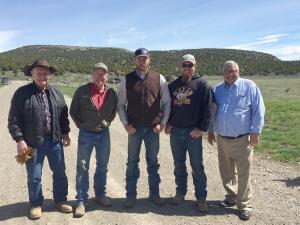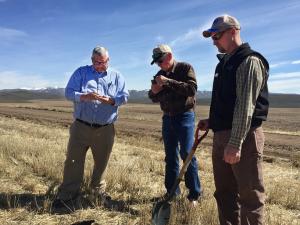USDA Under Secretary Visits Joint Chiefs’ Project on the Curlew
Under Secretary Bill Northey visited the Joint Chiefs’ Landscape Restoration Partnership project on the Curlew National Grasslands outside of Malad, Idaho on Tuesday, April 23.
Under Secretary Bill Northey visited the Joint Chiefs’ Landscape Restoration Partnership project on the Curlew National Grasslands outside of Malad, Idaho on Tuesday, April 23. The Joint Chiefs’ Landscape Restoration Partnership is a collaboration between the U.S. Forest Service and USDA’s Natural Resources Conservation Service (NRCS) to work together to improve the health, resilience and sustainability of areas where public forests and grasslands connect to privately owned lands.
The day began at the USDA Service Center where the Under Secretary met with staff from the Farm Service Agency and the Natural Resources Conservation Service as well as board members and staff of the Oneida Soil and Water Conservation District.

After viewing a short video about the overall project, the Under Secretary’s party went out to the Curlew to meet with some of the local landowners who participated in the project. These included Jay Hanson of Hanson’s Grain, three generations of the Eliason family (Don Eliason & Sons Ranch) and Dallan Nalder of Nalder Land & Livestock. In his conversations, Under Secretary Northey inquired not only about farming and ranching on the grasslands, but also about how the different families came to live and work there.
The Under Secretary’s was able to see two project locations, one on Hanson’s farm, and the other on U.S. Forest Service land a short distance from the Eliason and Nalder operations. Louis Wasniewski from the U.S. Forest Service explained the nature of the streambank restoration that would be taking place on the site and how that work is expected to benefit downstream landowners by reducing sedimentation in the stream.
This is the crux of the Curlew Area Restoration – multifaceted and interrelated projects located on the Curlew National Grasslands and adjacent private lands that were designed and implemented to improve the watershed and natural resource conditions across the target area. The individual projects focused on creating win-win results for both private and public land management in ways that benefit local farmers and ranchers as well as the wildlife and public that use these lands.

The overall Join Chiefs’ project included many partners beyond the U.S. Forest Service, NRCS and the local landowners. They include the Sagebrush Steppe Regional Land Trust; Federal Highway and Local Highway Technical Assistance Council; State of Idaho Office of Species Conservation; U.S. Fish and Wildlife Service; Oneida County; Idaho Transportation Department; Idaho Department of Fish and Game; Idaho Department of Environmental Quality; Idaho Parks and Recreation and the Curlew Grazing Association.
“I think the success here is the ability we had to take away private and public boundaries and apply conservation on a whole landscape-type scale focusing on one area,” said Laren Nadler, District Conservationist for the Malad Field Office. “This project enabled NRCS, the U.S. Forest Service, landowners and the Sagebrush Steppe Land Trust to work together for a common goal. The partnership worked smoothly, and everyone was satisfied with the outcomes. It has also opened doors for future conservation partner possibilities.”
The 14-minute video about the project can be found at: https://www.youtube.com/watch?v=Fy6bjUJiaZY  .
.

